Editor’s note: This article was originally published in August 2013. Updated April 2022.
Kousa dogwood (Cornus kousa) is a small tree or shrub native to Asia that is now a widely popular landscape plant in the US. And it’s easy to understand why… In Spring it will display a mass of delicate star-shaped flowers. And by summer you’ll have an abundance of peculiarly shaped but sweet tasting fruits. Kousa dogwood fruits are a brilliant edible that can be foraged from naturalized plants.
You may also know it by the names: Japanese Dogwood, Korean Dogwood, Chinese Dogwood, and possibly Szechuan strawberry. It’s one of three common dogwood trees that you’re likely to find in the US. Currently, it has only been naturalized in New York state, but it can be found further afield in various gardens and parks.
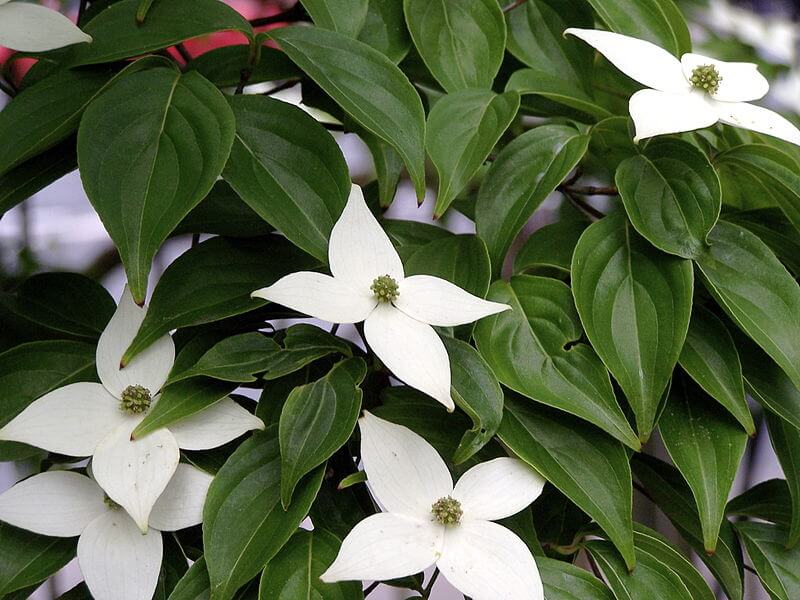
Kousa dogwood fruit and leaves: edibility and culinary use
The primary edible part of the Kousa Dogwood are the rosy red berries, which ripen in small clusters in late summer. The young leaves are also edible when cooked, but personally I have yet to try them. Kousa dogwood fruits have a very unique flavor for a temperate climate fruit. I often liken it to a cross between a mango and pumpkin, tropical, but with an earthy sweetness. The fruits are about the size of a strawberry but round (hence the common name Szechuan strawberry).
One issue is that there are usually a lot of seeds inside, so there isn’t always much of the fruit flesh to enjoy. Luckily, the trees produce lots of fruits, so it’s a case of selecting the biggest and ripest fruits to maximize the taste and texture.
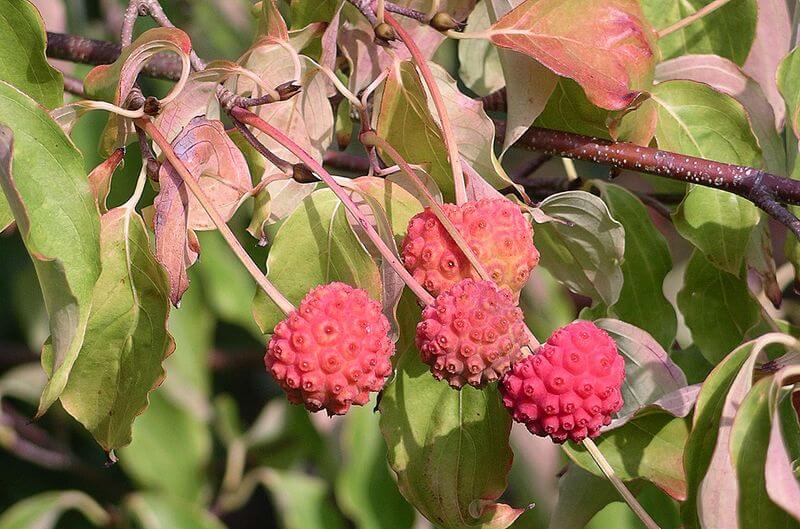
The fruit should be bright red and slightly squishy or soft to the touch. If it is hard then it’s filled with more starch than sugar and doesn’t taste nearly as good. The best way that I have found to eat Kousa dogwood fruit is to pull off the stem and suck the pulp right out, then spit out the seeds. It’s a great shot of flavor. The skin is edible but rough and grainy, so it’s usually best to avoid eating that part. As far as recipes go, you can use the fruit to create jams, jelly, and also desserts like pies and cheesecakes. Just take care to remove the seeds.
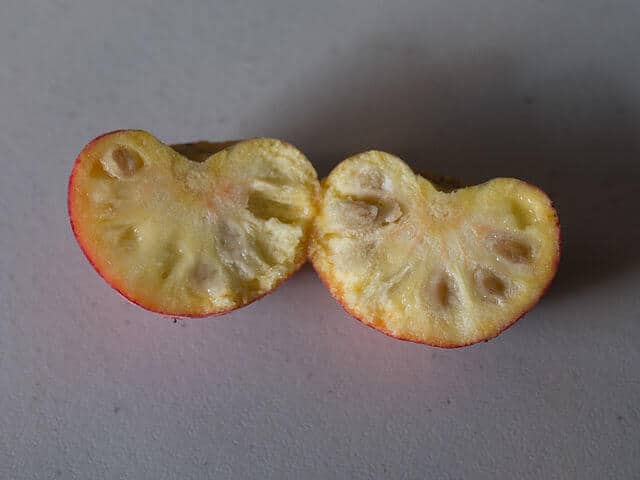
Kousa dogwood cultivation
If you don’t have any local trees, you can find Kousa dogwood saplings online if you are interested in growing your own. It currently has no major disease or insect problems in the US and is hardy down to USDA Zone 5. There is a fungal disease known as Cornus anthracnose which affects North American dogwoods. However, its effects on Kousa dogwoods are not well documented.
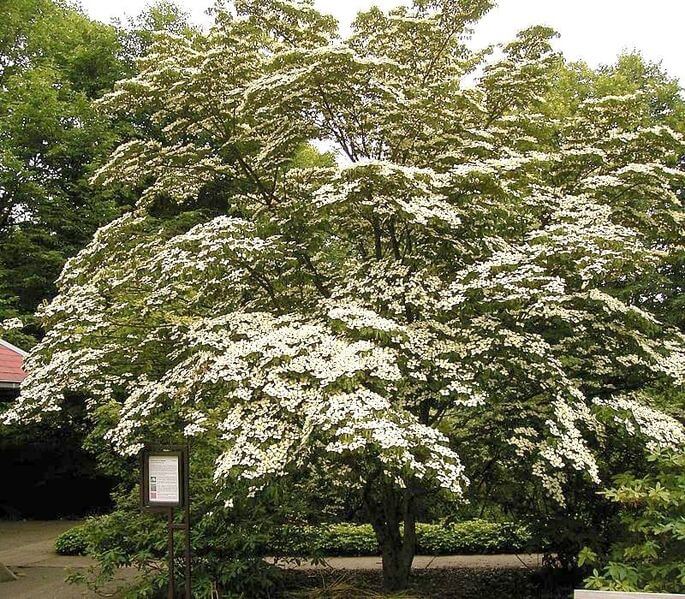
As a small tree/shrub, it’s a perfect choice for small gardens. Place it in full sun or partial shade, and dig in plenty of rich, moist soil and compost in the planting position. Kousa dogwood doesn’t tolerate dry spells very well. So, as the tree is maturing, mulch the base with additional topsoil or bark to keep moisture in. Because of its value as a garden ornamental, there are many cultivated varieties in existence for you to choose from.
Health benefits of Kousa dogwood fruit
Kousa Dogwood fruits contain calcium and plenty of antioxidants. They also contain anthocyanins which are water-soluble compounds that act like antioxidants. Because of these anthocyanins and antioxidants, Kousa dogwood fruits could help to reduce inflammation in the digestive tract and also benefit cardiovascular health. Studies are still being conducted on the benefits of Kousa fruit, and anthocyanins in particular, but anthocyanins are often present in many ‘super foods’.
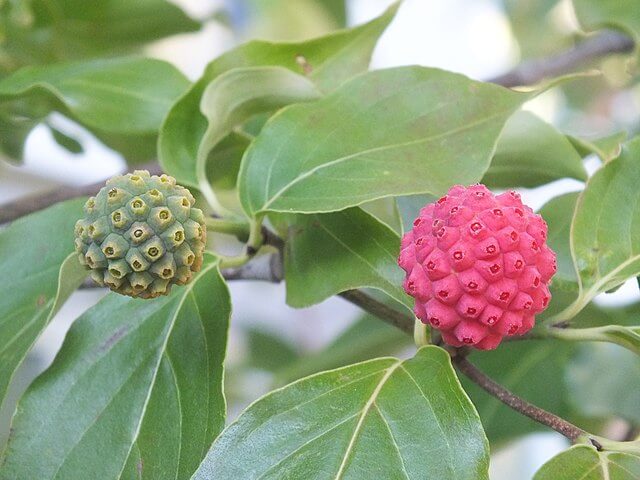
Conclusion
Kousa dogwood can provide beauty and value throughout throughout the year. In summer it gives us northerners a taste of tropical flavors not usually found in cooler climates. Not to mention the plant is primarily grown for its ornamental flowers which cover the tree in a beautiful display of white blooms in spring. For backyard foragers, find a local Kousa dogwood and keep an eye on it in late summer. It will soon be a favorite spot for a late summer snack.
Many of our readers find that subscribing to Eat The Planet is the best way to make sure they don't miss any of our valuable information about wild edibles.
See our privacy policy for more information about ads on this site







21 Responses
Found several of these Kousa Dogwoods while on the edge of the Connecticut River in Springfield MA – at Riverfront Park. This has been a city park in Springfield for the 31 years that I have lived here. The kousa dogwoods that I saw look like shrubs about 3 ft high with lots of fruit. Maybe they were planted there by the city at some point or maybe they are here as wild plants.
I actually live in southern CT, so i\I’m pretty close. I have not seen any kousa dogwoods that I suspected were growing naturally in the wild. I’m not saying it doesn’t happen, I just haven’t seen any. I would bet someone planted those at some point. Like you said, probably someone associated with the city.
I work in Princeton, NJ, and the office park where my office is located has at least five kousa dogwood trees, which are dense with fruit at this time of year (mid-September). I find the taste somewhat close to guava, which I grew up eating, in Central America. Some of my workmates have become fans of the fruit too, even if at first they weren’t sure they wanted to risk their lives eating a fruit that didn’t come out of a bag.
One question, any ideas about the vitamin content of the fruit?
I wrote this article a while ago. I’m not sure where I got the information that I included on nutrition. I even checked this database which I use a lot https://pfaf.org/user/plant.aspx?LatinName=Cornus+kousa and they didn’t have anything about the nutrition either. This is one of those fruits that I wish had more analysis and studies done.
There are a couple large Kousa Dogwood trees in Silverdale Washington state, in front of the Kitsap Humane Society. Loaded with fruit, and looking very old and healthy.
Sharon from Houston Tx near Cypress/Tomball. Was in Wheeling W Va. 9-11-20, visiting my grandson who just enrolled on a football scholarship. You think that’s a far drive..his roommate is from Nigeria!! On my first morning walk from the hotel I followed a sign to see some historical homes. Lining the sidewalk was a number of Kousa Dogwood trees, all loaded with ripened fruit. I’d never seen such a bumpy berry looking thing but I googled it right away. Because I used to make jelly I wouldn’t use the outer tart skin. To remove seeds I’d rub them around a metal strainer to remove much of the thick fruit. Add sugar, apricot or pear nectar vs water, simmer for jam
Sharon thanks for giving some of your kousa dogwood jelly recipe. I still have yet to make anything out of the fruit. I usually just taste it as I pass by at right time of year.
Is the Kousa the same as the Chinese Empress dogwood? I’ve planted a Chinese Empress two years ago which is healthy but no fruit has developed. Does it take time to fruit or should I have gotten a Kousa?
Are you getting flowers? I’m not familiar with that variety and weather what they need to flower and fruit. You’ll benefit from another nearby dogwood to pollinate though if you are getting flowers.
It looks like kousa is a very similar species to ‘ empress of china’ dogwood. ’empress of china’ is cornus capitata subsp. angustata ‘Elsbry’. they likely have similar edibility, although I read that empress of china is sometimes bitter.
re: “research is being done to determine weather we get any benefit…
I think you meant “whether”, not weather.
Thanks I fixed it.
I have a 20-foot kousa in my yard in East Tennessee. I always tell visitors the story behind it. I lived in Denmark for 3 years and our friends were always pushing us to speak Danish. One day I was told in English by a lovely Danish woman that I’d get a surprise if I was able to say a certain phrase in Danish. I did and was then asked what I wanted. I said with a smile in Danish “I would like a kiss.” The lady turned, slapped my face, and yelled, “I’m not that kind of a woman.” I went to my office and asked the interpreter what I’d done wrong. He said, “What did you say in Danish?” I told him and he just grinned. “In English, what did you want?” I said a kiss. “Now laughing, he asked, “Did she slap you?” “Yeah, rather hard, in fact!” Leaning forward, he drew me near and said, “You may have wanted a kiss, but you asked for her vagina instead.” Obviously, I later apologized multiple times for my mistake. After returning to the States, I saw this dogwood on sale. It was a kousa, which in Danish is something you don’t ask for from a casual friend. I bought the tree as a way of remembering my unforgivable blunder.
Are the berries poisonous to dogs?
I received two dogwood trees from the Arber Day Foundation yrs ago. One of them flourished and now has berries in the fall. I might try making some jelly. I just found it strange that they came free for a small donation.
Thank you for the info,I can’t wait for morning as I lay here.i am a country boy from S.c.and have three trees in my yard now the berties are ripe, I have tasted them but never just enjoyed them.only because I knew nothing about them. Thank you again
Last Sept-Oct I first tasted the fruit and enjoyed. That was 2022. This year the same tree is not with fruit. Why? Is it the warmer weather? Washington , DC area.
Those seeds you discard are easy to sprout to create new trees. I just put them on top of the soil in the fall and cover with mulch. The next spring (and for a couple of springs after the 1st) they sprout. I have to protect the young plants from deer.
I have two beautiful kousa trees, they have been loaded with fruit for at least ten years. I always wondered whether the fruit was good to eat. I have lately found seedlings from it in other areas of the garden and have potted them for giving to other gardeners. This year I am going to try making jam.
Thanks for spreading information about this beautiful trees.
There are 2 kousa trees that were planted in a cemetery in North Eastern PA. When I squished it, the inside smelled so light and sweet similar to a peach. I looked up the fruit before trying it and the taste reminds me of peach and persimmon! They’re really tasty and for now I’m the only one who picks the berries.
found 1 in the uk 🙂